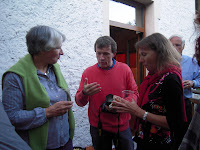








Bonjour mes amis! Last night we hosted a "soirée" with my colleagues at Lycée Vaugelas. What fun we had reminiscing about our year together! We had lots of laughs talking about the fun times this year as well as the challenging ones. I know that any worthwhile venture involves the positive as well as opportunities which allow us to learn and grow and "rise to the occasion". Lee and I will never forget the kindnesses, the friendship, and the love shown by our friends in Chambéry. They honored me with a lovely picture of Chambéry from the 19th century. I can't wait to hang it in our home in Richmond. This has been quite a year for us. I am honored to have had this opportunity and to have been able to share it with you all. Merci bien to those of you who have traveled with us this year through my blog. I have loved sharing! See you in Richmond.
A Bientôt!
Mme. Wallace


















